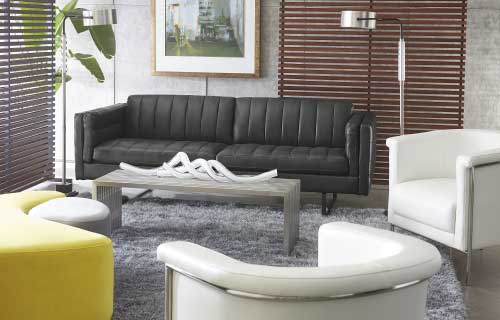Stools are useful furniture pieces that can fit perfectly at tall tables, built-in breakfast bars, and counter seating areas. The key to successfully shopping for this unique furniture piece is simple: height. If your chair is too tall or too short, it won’t be comfortable or useful. Learn more about the differences between bar stools and counter stools before outfitting your dining area.
Height is arguably the most important selection criteria for bar and counter stools, and it’s also the characteristic that sets these two types of stools apart. Although counter stools are shorter than bar stools, there aren't standardized sizes for either option. This is mainly due to established kitchen design standards that are based on studies that have determined what the most practical dimensions are for the average home dweller. Here are a few guidelines you can keep in mind when making your selection:
The CORT standard for stool measurement takes the total height of the stool from bottom to the top of the backing into consideration which is why its important to know the difference between a countertop and a bar-height countertop. Both are intended for similar uses and come close to the same height which makes it important to know which one you have before choosing your stools.
According to the
American National Standards Institute, the established ergonomic height for standard countertops are 36 inches above the floor. Bar-height countertops are positioned 42 inches from the ground.
Which One to Choose
Because the difference between a counter top and bar-height countertop can come down to a matter of mere inches, it’s important to be precise when you shop. It’s really helpful to measure your bar, counter, or table, if you can, before choosing stools.
Counter stools: Typically have a seat height of less than 24 to 26 inches
Bar stools: Typically have a seat height of 36 inches
Start your measurement from the base of the table or countertop, and measure straight down to the floor. Take that measurement (in inches) and subtract 10. The number you get from that simple arithmetic provides a good general guide to how high the stool’s seat should be. If the number is greater than 30, look at bar stools; if it’s less, focus on counter stools. If you can’t get a measurement, you may want to focus on adjustable-height stools instead of trying to guess what might work.
Other Measurements
Height is important, but it isn’t the only thing to consider when picking out stools. It’s also important to take width into consideration. If you plan to have multiple stools lined up next to each other, it’s best to leave at least 14 inches of space between stools or between a stool and a wall. This allows guests to sit comfortably without bumping into anything.
Measure the total width of your counter or bar to determine how many stools you can comfortably fit based on width. If you’re dealing with a table, measure each table side to make this determination.
Stool Formats
Aside from height, style is an important consideration when shopping for stools. Stools can be backless or have a backrest and arms, much like a classic dining chair. Backless stools can look sleek or industrial, while stools with backs are often more comfortable. It comes down to personal preference, but if you know you like to lean back when you sit, you may want to go for a model with a backrest.
One thing that’s important to keep in mind is that the overall height measurement of a stool may increase due to a backrest. If a stool is described as counter height, but has a total height measurement of more than 30 inches, it probably has a back.
Materials
Bar and counter stools are typically made from durable seating materials like metal and wood, with or without upholstery. The materials you choose affect comfort and style. These tips should make it easier to narrow down which materials are right for you:
Metal: Durable and sleek, possibly metallic in color or powder-coated with a colored paint
Wood: May be heavy and difficult to move but offers a classic look and feel without sacrificing durability
Upholstery: Usually padded, which offers more comfort for long-term seating
It may be easier to consider material after thinking about measurements. You can always decide which styles appeal to you and then base material choices on those styles.
Ultimately, the choice between bar stools and counter stools comes down to your needs and your style preferences. Measurements are key to ensuring you end up with the right type, but don’t discount how important it is to like what you see and enjoy sitting on it.
CORT Furniture Rental offers an impressive selection of bar and counter stools to fit your home or apartment. After determining your measurement requirements and style preferences, browse our catalog to see which stools are right for your space.


